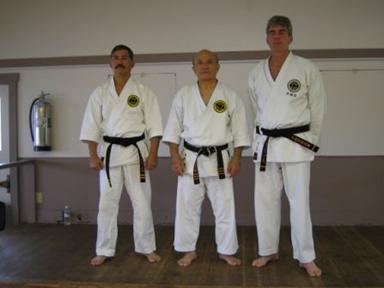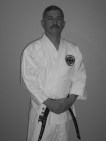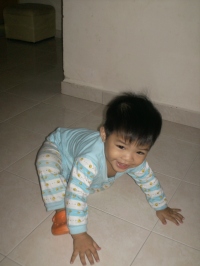
Question : What makes a good instructor?
Answer : In my opinion, a good instructor is one who listens well, and teaches with a passion to instruct students in the techniques and philosophy of Seibukan karate-do and life’s lessons. The teacher must be knowledgeable of what they teach, but not with egotism and a lack of compassion and understanding. A Seibukan sensei is committed to maintaining the excellence of his art, his personal physical fitness and mental training, and be an example to all practitioners of Seibukan karate-do and other martial arts.
Question : What is Zenpo Shimabukuro Hanshi like?
Answer : As in the comments I stated in the question “What makes a good instructor?”, these attributes I have found in Hanshi Zenpo Shimabukuro, and more. He is a great man and a great sensei. I have trained under this great man for many years, and each time, I learn something new, something to energize me to train harder and learn more. He is a gentle giant amongst us, yet has powerful techniques with bursts of speed and accuracy in delivery of his techniques. These are reasons why he will be my only sensei through all my lifetime.
Question : What can you say what karate means to you?
Answer : Karate-do means many things to me, but primarily it gives me a path to follow in my life. It means having patience, to be understanding, disciplined in areas of my life, finding ways to apply my training in a positive way, but with the knowledge that my training also has a physical and potentially destructive element within it. The ability to use karate techniques for self defense purposes. This is where discipline of ones passions and temperament are very important.
Question : What are your technical interests at this point in your training?
Answer : To maintain good technique and fitness in my body, and practicing the bunkai applications. This can only be done by practicing my basics and kata, and involving both mental and physical conditioning and focus. To not train is to lose technique.
Question : What is your opinion of sport karate today?
Answer : In my early days of studying and teaching Seibukan, I was actively involved in sport karate tournaments. After a while it became apparent that sport karate required one to change their technique to score points. This was a deviation away from what the bunkai of our techniques was. Once rules are no longer controlling the battle, martial artists can be reduced to a more primitive form of fighting, to survive, not to score points. So, at my point in my life, karate-do is a way of life, not a way of sport. I do enjoy watching sport karate matches, and admire the skills of the performers, but reality is what it is in the streets where no rules exist.
Question : Who was your biggest influence in your martial arts training?
Answer : I have to admit that in the beginning, and what made me interested in karate and gung-fu, was Bruce Lee. As I grew in Seibukan and began training under Hanshi Shimabukuro, the image changed. So, my biggest influence for many years has always been Hanshi Zenpo Shimabukuro.
Question : What are the major points in attaining high-quality kata?
Answer : Practice, practice and more practice of the moves in the kata, over and over again. But with a purpose. Be precise, and emulate the kata performance and precision of those who influence you the most. If all students tried to look like Hanshi Shimabukuro in their movements and show of strength in execution of technique, I truly believe they would achieve higher quality of kata performance. Also, applying the basics of kihon renshu and zenshin kotai to the appropriate kata techniques will help improve the quality.
Question : What are the good and bad sides of competition?
Answer : The good side of competition, especially for the younger students, is to add that element of personal competition, which is in all human beings. It also can help a student achieve more self confidence from entering into a controlled environment of competition, personal kata performance and against a kumite opponent.
The bad side would be if one concentrated their training regiment and changed their techniques into a competition favorable form, to score points, win matches and trophies, then I believe you stray away from the true study of a martial art. This takes away from learning the traditional techniques of the art, and traditional techniques and philosophy is what makes Seibukan a unique system of karate-do.
Question : How has martial arts changed in the last 30 years?
Answer : Politically, yes, we have seen some changes, which is unfortunate. Some students traveled off into different and wrong paths in their martial arts careers, and are no longer with us. Some try to claim lineage or direct training with the Shimabukuro family. Some feel they are entitled to start their own organizations under the guise that they are sanctioned or at one point were associated the Shimabukuro family. This type of activity is not supported or recognized by the IOSSKA and Hanshi Zenpo Shimabukuro as legitimate. Its human nature and involves ego, and again, very unfortunate.
Seibukan, as a karate system, its techniques and kata moves, has not change much at all over the last 30 years. I know this because I have been a student of Seibukan for 37 years. What is exciting is that most of the techniques we practice and perform were done by the greats, like Chotoku Kyan and Zenryo Shimabukuro. Very exciting to know this fact.
Question : Is there a particular message you want to share with your students or karateka in general?
Answer : All karateka must follow their hearts. Change is a normal process in life. Some things we cannot control, some things we can. What we can control is where Seibukan can bring value to, like family and business interactions, personal goals, dealing with our fears, etc. For the events in our lives that we cannot control, the discipline of our minds and bodies helps us deal with difficult situations. If one believes in Karma, then here to I believe training in Seibukan can help us make good choices, not bad ones. Lastly, honor Seibukan and the Shimabukuro family for what they have brought all of us in our study of karate-do. Honor your family, your elders, and know the difference between what is right and wrong.
Question : In summary, what is next for you?
Answer : To continue to honor Hanshi Zenpo Shimabukuro and his family, and train in Seibukan until my last breath. Even though a person may not throw a punch, execute a kick, practice a kata, if you are a karateka, your experience and training will always be with you, in your mind and body.
To read the first part of the interview [ click here ].





